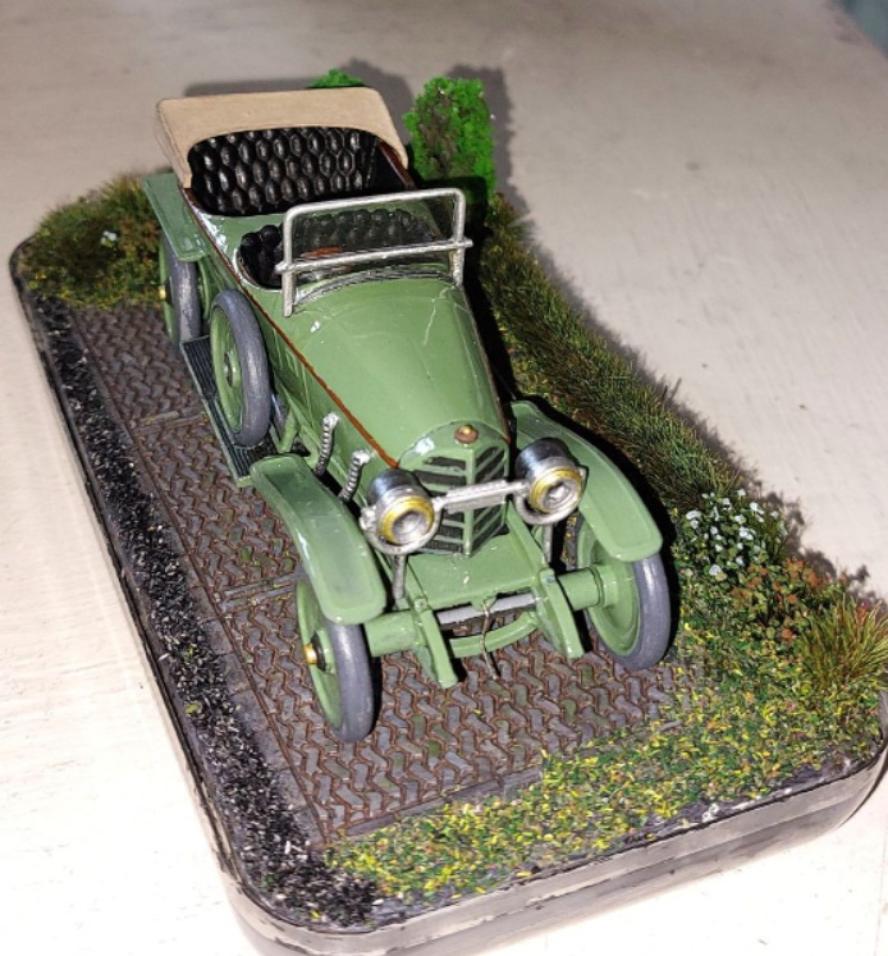
1913 Mercedes Type 37/95hp Torpedo.
Mercedes 35hp model of 1901 had taken DMG in a new direction. The Maybach design intending "comfort by means of simplicity". By the standards of 1901 it was a straightforward car that was relatively easy to drive, the name 'Simplex' was to promote this new ideology. The 1902 to 1909 production Mercedes Simplex followed the same principles. With a low centre of gravity and engines that could produce from 40 to 60hp, the Simplex was comfortable and powerful enough to attract praise from owners, and to take racing victories.
The next top line model from DMG went in a different direction again. Treading a line between racing car and general purpose luxury car, the Mercedes 37/90hp was something of a high-performance touring car. Considered “the most powerful production automobile in the world”, it has since been described as ”the SSK” of the 1910s; high praise for a car not primarily designed for sports racing.
Designed by Paul Daimler the Model 37/95 was one of the earliest Mercedes cars to have the pointed radiator and exhaust pipes exiting from the sides of the bonnet. It was designed with luxury in mind but performance on tap. Not a racing car or a 'normal' road car, this was to be the most modern and powerful production car available. Expertly crafted in its construction the front longitudinally mounted engine and the transmission fed power via a prop' shaft to a cross mounted driveshaft. This then transferred drive to the rear wheels by chains within enclosures and oil baths, this was to be the last chain-driven Mercedes design. The new brake and suspension systems carried an elegant body with a well appointed interior and carriage-style convertible top. Electric lighting took over from earlier gas systems.
Daimler's new high-performance design went on sale in June, 1911, and was continuously refined through until 1915. Three major steps mark the progression starting with the original Mercedes 37/90hp which was produced from 1911-1914. The 37 part is the German tax category while the second, 95, is the cars rated horsepower.
The new DMG top model was superseded by the 37/95hp in 1913 when Saoutchik of Paris exhibited their version of the latest chassis at the Paris Automobile Salon. The last model went into production in 1914 as the 38/100hp. War production would take over the DMG order books and bring an end to Mercedes-Benz car development until 1919.
1911 37/90hp
Production of the 70mph, 37/90hp, began in 1911 with the 9,530cc, 90hp engine. The previous 6-cylinder engine technology, used since 1907, was dropped in favour of a new in-line engine of 4-cylinders. This consisted of two vertically orientated sets of joined 2-cylinder units, each having welded on cooling-water jackets. Each 130mm bore x 180mm stroke, cylinder had over-head valves operating one large intake valve, two smaller exhaust valves within each of the paired heads. Driven by pushrods actuated by two lateral camshafts low in the side of the engine which were driven by gears taken off the centre of the crankshaft. Interestingly the single inlet valve cam is set much lower than the two exhaust valves cam. This system provided a shorter, more efficient, combustion cycle alongside the dual spark plug ignition system. A single Mercedes designed sliding piston type carburettor provided the petrol/air mixture and in this form the motor was factory rated as 90hp @ 1,300rpm.
The engine sends power through a 4-speed gearbox. The manual operating lever for the gate gear change was outside the body on the right hand side, that's correct, European cars were right hand drive back then!
As previously mentioned the final drive was by chains to the rear wheels. Mercedes smaller car already had full propshaft drive but the high torque larger units might be behind the choice to continue with the noisy chain. However, the encapsulation of the drive chains within fully enclosed oil baths must have done much to deaden the noise. Incidentally, the drive shafts to the chain wheels had the water cooled mechanical brakes operating on them.
The new suspension design of semi-elliptical leaf springs provided a compromise between a comfortable smooth ride and the need to provide excellent handling and stability. A compromise it made with ease.
A dry rolling chassis had a weight of approximately 1,525kg. This would have increased with oils and lubricants not to mention the addition of 125 litres of petrol in the fuel tank situated low in the rear of the chassis.
This popular car was further refined for the demanding clientele of the era, as you will see as we move to the 1913 specification next.
1913 37/95hp
A big step forward came with the 1913 version. The multiple blocks of cylinders became one single unit. Daimler took his previous engine design principles and created a four cylinder engine block of 7.2 Ltrs. A flywheel magneto provided power for the electric systems. Peak power at 1300rpm was increased to 95hp. With a special lightweight body one of these Mercedes very nearly broke the 100mph target. Performance was impressive for 1913 with the car able to reach
The car could reach 60kph, around 37mph in 10sec's, and do 0-100kph in just 12sec's. Even with the standard double phaeton style body the car could do 130kph. Fuel consumption wasn't bad either, 22Ltrs could take the vehicle 100kilometers.
Other improvements included an adjustable wind shield, an oil pressure gauge on the dashboard and a new state-of-the-art braking system consisting of expanding drums on all four wheels. The track, front and rear was slightly increased to improve the stability and handling further.
1914 38/100hp
18 months after the 37/95 came the 38/100hp. Engine displacement was now raised to 9.8Ltrs but in most other ways the car remained much the same. Of course it was faster again, but the world was moving headlong towards war, even if it didn't realise it at the time. Many of these cars would become the staff cars of the German military.
Body styles
A top of the range DMG chassis of advanced design, still needs a body for the driver and passengers to travel in comfort. DMG offered a small range of in house bodies, often sports, racing and touring styles, but, in common with many top motor car manufacturers, DMG often supplied only the chassis. That went via a coach-builders of the customers choosing.
A popular style, whether by Saoutchik, Labourdette, Van den Plas or any of the top firms of the era was the Double Phaeton-Torpedo. Saoutchik and Labourdette were particularly well known for their Torpedos. Labourdette's wooden Skiffs also stood out from the crowd too, but the standard touring body was probably the most common. Particularly when WW1 broke out and Germany required an abundance of staff cars.
However, meticulous attention to detail set the Paris based firm of Jacques Saoutchik as the premier choice for a Torpedo Speedster. Saoutchik's close relationship with DMG began in 1906 with the firm soon becoming a very important DMG partner for specialist coachwork requests.
Their design for the Double Phaeton Torpedo Speedster was adapted from the Mercedes factory touring cars. The rolling chassis, a technical marvel of its era, was fitted with a much slimmer and lower body, giving the car a particularly sporty attitude which was further emphasized by the external exhaust pipes emerging from the sides of the front body.
Expertly crafted wooden body panels, hand crafted brass and wood accents fitted to steel fames provided a solid base for the interior seating and drivers' compartments which in turn featured a number of amenities. Elegant body lines, spacious interiors with sumptuous leather upholstery seating as many as five people, provided both style and practicality.
This impressive combination of luxury, power, and handling, was then exhibited by Saoutchik at the 1913 Paris Motor Show. It attracted much attention, but the exorbitantly high price led to only 15 Saoutchik Torpedos being built. Of that small number only six still exist.
Racing
A sporty design equipped with a powerful engine leads people to think about motor racing. While the 37/90hp models racing in Europe, having to compete with the best of the continent, didn't fair very well they were the test-bed that lead to the return of Mercedes team to racing in 1913 with drivers Christian Lautenschlager and Otto Salzer.
The engine was the muscle that worked in the USA. Ralph de Palma fitted a 37/90hp engine into a 1908 Mercedes Grand Prix chassis and won the the Elgin Trophy Vanderbilt Cup through 1912 and 1914.
Legacy
Top of the Daimler Motoren Gesellschaft model range prior to WW1 this was arguably the worlds first supercar. Owned by Royalty and raced by superstarts, only World War halted its progress.
Having a chassis and engine designed by one of the top men of the pioneer era in Paul Daimler (and boasting a number of impressive features), it is little surprise the that some of the best coach builders of the the era put their own mark on the bodywork styling. Stylists like Henri Labourdette and Jacques Saoutchik to name but two.
From the enclosed bodywork of the King of Bulgaria's 1912 luxury 37/90hp saloon to stripped back light-weight bodywork of the 1913 racing cars, this model stood out as a design success. As a platform for expression and a statement of class. This most advanced design, the first Mercedes with the pointed radiator and external exhaust pipes, marked the end of chain driven DMG cars, a design that had begun with the 1897 "Phoenix" cars. It was an object of desire for car enthusiasts then, just as it is today. A car that made its mark at the time, and still holds a place in the chain of automotive design today.
Production of the 38/100hp stopped with the outbreak of war, the firm naturally turning over to the national effort. But that didn't mean the cars were out of work. Not a typically representative use of the powerful sports touring car, but non-the-less making full use of the cars best attributes, the hitherto conservative German Army mobilised many civilian Mercedes 1913 37/95hp auto-mobiles for use as a staff car in both the German and Turkish Armies. All of course, hastily repainted in the Feldgrau colour.
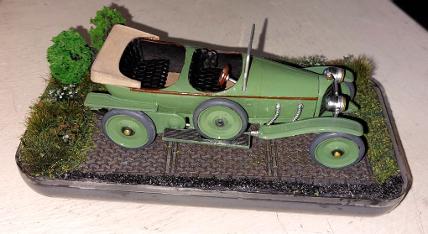
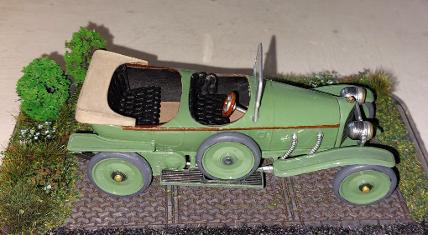
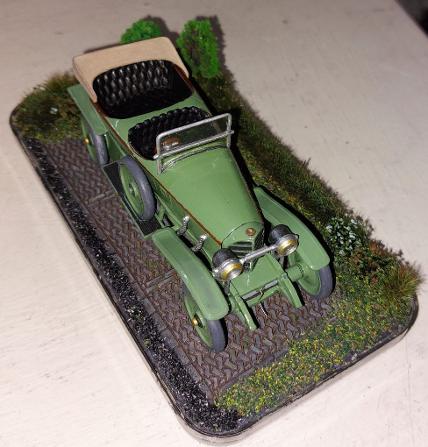
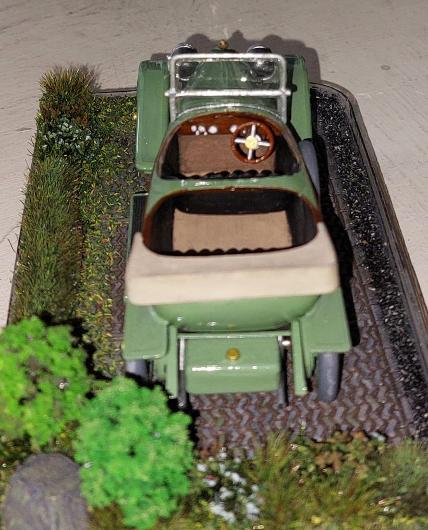


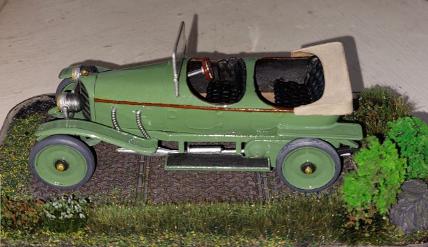
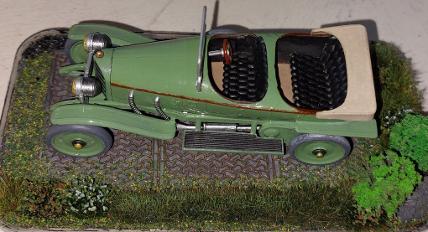

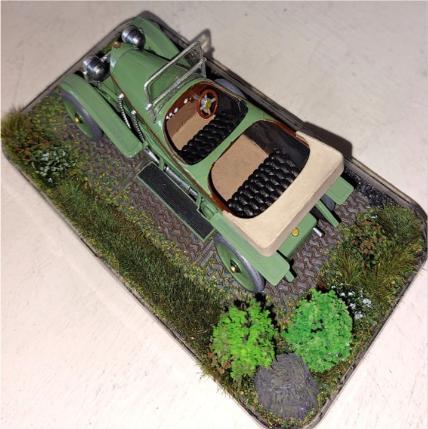
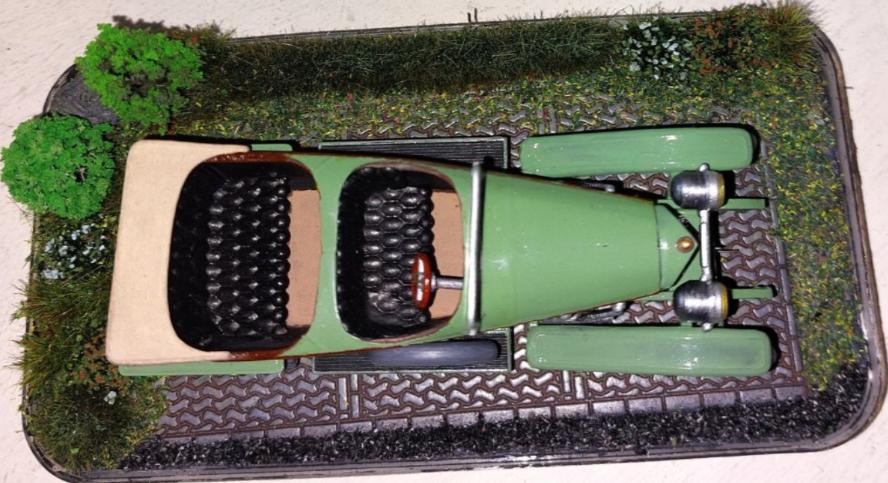
Yamada 1913 Benz Torpedo kit
Yamada was one of the earlier plastic kit manufacturers in Japan, the estimated founding of the company being around 1960. Their model kit range expanded to included the usual type of subject genres; and a large amount of them. The earliest motor car kits are the three mentioned here. The scale is not recorded anywhere I have found, so cannot be confirmed. It appears to be a lot smaller than 1/32nd and much closer to 1/43rd scale.
Later, Yamada released car kits covering a lot of Japanese and American automobiles in 1/24th and 1/25th scale. Some of the subjects are quite unusual and one has to say, it is well worth spending a little time looking at the kits Yamada released. Some will be quite familiar due to mould sharing with other companies, other kits are more unusual and very rare.
This Model was donated to the museum by Mr. Derek Bonas, around 2002. Being a road car it resided with Rod awaiting restoration. It was past to Ian recently as arthritis is now preventing Rod from manipulating the smaller models and the restoration needed to be completed. Stripped down and reassembled as if built straight from the box. The plastic proved to be very brittle and parts needed careful handling. In the end this kit has proved to be worth the effort, if only for the historic value it holds as a rare item in the UK. Painted with Humbrol enamels, art-Deco and citadel acrylics before being mounted on a base built in a Ferrero Roche box with a little scenery for effect.
The three cars of this early production era are as follows, Yamada never released any other motor car kits in this scale.
Old Car Series no.1 – 1912 Packard 1-48 Victoria 1964 new tool re-boxed 1965.
Old Car Series no.2 – 1913 Benz Type 37/90 1965 release re-box 1968
Old Car Series no.3 – 1908 Cadillac model G 1965 release re-box 1968
Old Car Series triple set no. Ycl-400 released in 1973
RETURN TO :-
